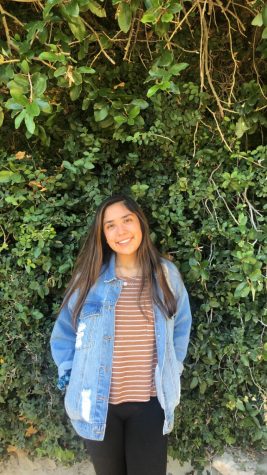Professor studies link between church attendance and crime
March 22, 2022
Assistant Professor of applied microeconomics, Jonathan Moreno-Medina, is studying the effect of church attendance on crime and how weather conditions can affect the relationship between the two.
His research stemmed from the archaic hypotheses speculating how church attendance and religious behavior can affect crime activity.
“That hypothesis has been put forward for a while, but most of the studies I have seen up until mine and other recent ones presented evidence in terms of correlations,” Moreno-Medina said.
What Moreno-Medina means is previous research has observed correlation rather than the causation of religion’s effect on crime.
“For instance, if you were deciding to commit a crime and no one was going to see you, then you might be inclined to do it, but if you believe there is an omniscient being that is seeing you 24/7 then you can’t escape that vigilance and you could potentially get punished later in the after-life, so that might curb potential criminal behavior,” Moreno-Medina explained.
He also mentioned social bonds could have a correlation with crime.
“You have the potential challenge of religion being formed in the way that creates social bonds among people and then perhaps you are less inclined to commit a crime against someone you know,” Moreno-Medina said. “There is the fact that your peers might look very different once you start to engage in religious communities. We know that peer effects can be important. For teenagers, if they are around a group that is less likely to commit a crime then they might also be less likely.”
Moreno-Medina also mentioned hypotheses that speculate the reverse effects on crime. Religious behavior is another type of tribal behavior, so an individual might grow closer and engage in less criminal behavior against their own community, but be more likely to engage in crime against other groups, creating divisions among other religious communities.
Despite such conclusions, Moreno-Medina also noted correlational studies still do not say much about the causal effect of religion because religious behavior might be associated with other variables associated with crime, so there isn’t a direct cause between religious behavior and crime.
“You can imagine that maybe religious behavior is higher in communities in which they might be sufficiently well off, so they can spend more time in church and in community, but that might also be driving down crime rates at the same time, so that might be expanding that correlation, but it is not because religion is driving down crime rates,” Moreno-Medina said. “It might also be the other way around in places in which crime rates have decreased, you can more comfortably participate in religious celebrations with your own community and so on. There are several reasons why the correlational analysis is not enough.”
Therefore, it is necessary for research to look at a variable that does not change the rate at which people attend religious services and that is not directly related to crime. Moreno-Medina says if you can leverage that variable, then one can determine the causal effects of religion and crime rather than solely a correlational relationship. Essentially, the research has to consider changes in church attendance that occur at random. Therefore, Moreno-Medina uses weather to describe the relationship between religion and crime.
“That’s where I use precipitation. I look at the places where religious communities gather, between 9 a.m. and 1 p.m. on a Sunday, and at the precipitation at those specific times throughout the year,” Moreno-Medina said. “If you had 52 Sundays in the year and you had precipitation more than one year over the other then you are more likely to attend church when it was not precipitation versus when it was.”
Moreno-Medina found that when it precipitates, the probability of attendance to religious services decreases by 20% and from there evaluates different types of crimes. Rain at that specific time and crime can be considered random, therefore looking at the relationship between crime and the number of Sundays in a year in which it rained can help evaluate the effect of attendance on crime.
“If you are more likely to go to church when it’s not raining, less likely when it is raining and looking at the rain at the specific time window I can see the causal effect.”
Using hourly precipitation data from the U.S. Department of Commerce’s National Oceanic and Atmospheric Administration, Moreno-Medina was able to examine the relationship between county-level rainfall during church and crime.
“There is strong evidence that religious services decrease crime rates for substance-related crimes, things that have to do with alcohol and drug consumption,” Moreno-Medina said. “There is some evidence that white-collared crimes might change a little bit, but I don’t see an effect for other more serious crimes. I don’t see increasing religious participation decreasing serious crimes like homicide, aggravated assault, burglary or rape.”
While Moreno-Medina’s research leans towards the fact that religious participation can alter certain behaviors, as mentioned before, the causation is still not clear.
“Overall, what I end up concluding is this debate is in between,” Moreno-Medina said. “It’s not showing that religious behavior is absolutely necessary for crime rates to go down since I don’t find the causation in all types of crimes.”
Moreno-Medina explained what he was most excited about when conducting the research.
“I really enjoyed the fact that there has been this debate going on for several years and new data, new statistical techniques and advances in research allowed us to make strides in the age-old question, what is the role of religion on crime,” Moreno-Medina said. “We can actually move from speculating and hypothesizing on the logic we think the world is supposed to have and actually look for evidence one way or the other. I really liked that I could tackle this old question with new data and techniques.”
Aside from his research on the relationship between church attendance and crime, Moreno-Medina broadly specializes in public, urban and media economics. He has looked at what happens when there is a migration wave in a developing country and what might affect the sentiment of the population and how the bias in media coverage, especially in the coverage of crime, can affect housing markets in terms of prices and housing segregation.
For further research, Moreno-Medina plans to explore whether changes in beliefs, peer effects, etc. influence the church attendance and crime relationship.








